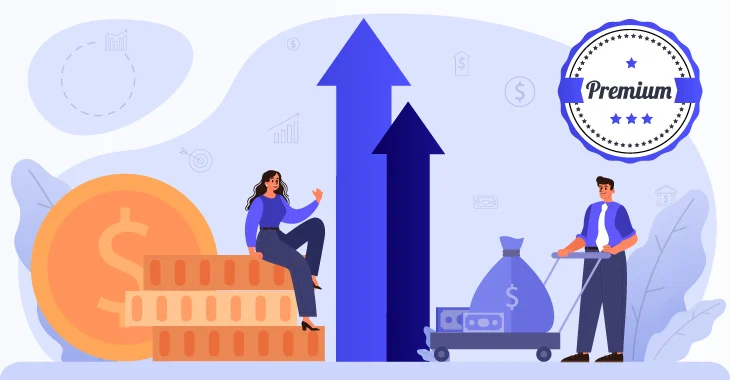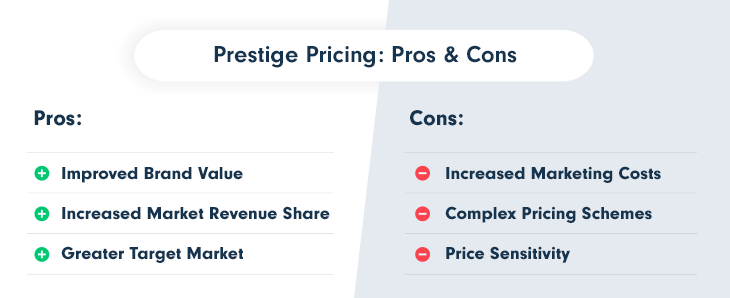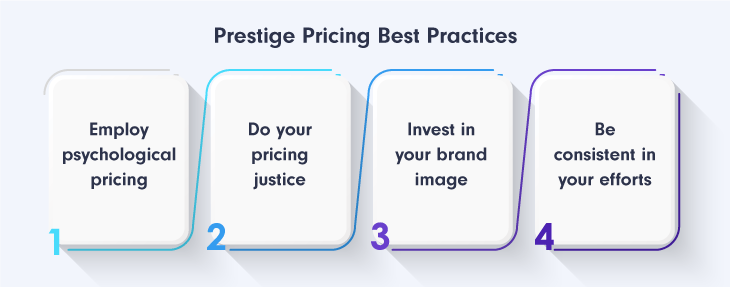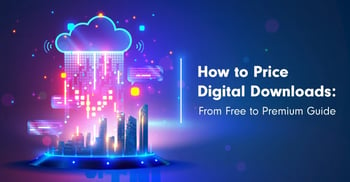What Is Prestige Pricing?

With 2023 approaching its final chapter, your mind is probably on your goals for the new year. And speaking of the year ahead, are you thinking about how to increase your profit margins?
Let’s talk about the simplest way to achieve this goal!
Raising your prices, of course, will accomplish this. Consider this: a mere 1% increase in your prices can lead to an impressive 11% improvement in your profits. Not a bad proposition, is it?
Only, some might argue that there’s more to this than playing with numbers.
We agree. It’s not just high prices. It’s better pricing.
Check out our complete pricing guide to find out how you can excel in the art of pricing.
And now, for the topic of our conversation.
Prestige pricing, the monetization technique behind the saying, It’s better because it costs more. So, let’s dive in and discover:
What Is Prestige Pricing?
The prestige pricing strategy leverages higher prices to convey the idea of quality and exclusivity. But there is more to this technique than simply having a higher price point.
Businesses employing prestige pricing must continually reaffirm the value of their products to their target customers and establish a better brand perception. And they must do so in a manner that resonates with their audience.
In essence, the reason why prestige pricing works lies in the audience's belief that they are receiving enhanced value for their investment.
The Pros & Cons of Prestige Pricing
While prestige pricing strategies are widely used in both B2B and B2C realms, it's important to recognize that every coin has two sides.
Understanding the advantages and disadvantages of this approach will empower you to determine whether prestige pricing aligns with your SaaS offering.

The 3 Pros Of Prestige Pricing
Improved Brand Value
Prestige pricing is also known as premium pricing, and for good reason.
You see, when employing this monetization strategy, raising your prices is only one step of a larger marketing strategy designed to position your business as a premium brand.
Once you succeed in cultivating a strong brand image that justifies the higher price tag, convincing customers to pay for your services is easier.
Additionally, a polished brand image will always be a consumer magnet. And that’s always good for business.
Increased Market Revenue Share
In the eCommerce market, the traditional approach to achieving a higher profit margin is capturing a greater market share.
However, when embracing the prestige pricing strategy, you need to adopt a different metric for business success: value.
With the prestige pricing strategy, your revenue will actually come from charging fewer customers more.
Greater Target Market
It's important to keep in mind that the prestige strategy heavily relies on psychological pricing. Unlike other methods, this approach hinges on how potential customers perceive your products in order to achieve your desired outcomes.
As long as you put sufficient effort into cultivating a sense of value, you will win a new audience group, appropriately called your premium segment.
And, as you know, there is strength in numbers.
The 3 Cons Of Prestige Pricing
Increased Marketing Costs
Just like Rome wasn’t built in a day, establishing your offer as a premium product takes time. And in business, time often means expenses.
Investing in techniques that allow you to create the impression of value and maintain it over time may prove to be quite expensive, and higher prices might turn against you.
Complex Pricing Schemes
Offering these price points to different customer segments means utilizing a very complex pricing structure.
Often, the existence of multiple pricing tiers, while necessary if you decide to use prestige pricing, can confuse customers.
A way to solve this challenge is to clearly communicate what each pricing tier offers and whether these are additional features or other benefits. In this context, exploring three-tiered pricing strategies can be particularly effective.
Price Sensitivity
The last few years have gifted us with a crucial insight.
In challenging times, consumer spending behaviors undergo transformations. During such shifts, price-sensitive consumers wield considerable influence over your business.
Reluctant to pay premium prices, your sales might go down, and with it, your business’s profitability.
Automatically sticking to lower prices will not solve the problem. Such a move may inadvertently alienate another type of audience: your premium customers.
3 Prestige Pricing Examples
While we often associate prestige pricing with B2C sectors, such as luxury car companies and fashion labels, SaaS and software companies can effectively employ this strategy, too. Here are three well-known examples.
Oracle Siebel CRM
A powerful CRM solution branded by none other than the juggernaut Oracle, Siebel CRM is an example of how well a SaaS business can practice prestige prices.
And it’s easy to understand why.
Thanks to its extensive feature set, impressive scalability level, and strong brand reputation, Oracle Siebel is perceived as having superior product quality.
And let’s not forget Oracle tends to target enterprises with complex technical needs and deep pockets. They can afford and are willing to pay the premium price for Siebel CRM because they are convinced this is the best alternative on the market.
Adobe Creative Cloud
Now a household brand among designers, Adobe Creative Cloud is a wonderful example of a SaaS product practicing prestige pricing.
Widely recognized as a high-quality product with a solid brand reputation, customers around the world perceive Adobe Creative Cloud as one of the premier options in the web design industry.
This allows the SaaS solution to use this high-price strategy with professionals in their targeted audience.
LinkedIn Sales Navigator
LinkedIn Sales Navigator, a tool designed for B2B users aiming to enhance their sales pipeline, serves as another great example of a SaaS solution effectively leveraging the prestige pricing strategy to increase profits.
In this instance, it is rather obvious that the principal success driver is none other than LinkedIn's renowned network reputation.
Launched in 2003, LinkedIn introduced Sales Navigator in 2014, demonstrating a deliberate approach to first building a robust market presence and user base over time.
4 Prestige Pricing Best Practices
Prestige pricing might give the impression that it’s reserved solely for businesses with an immense marketing budget. But that’s not the case. All businesses, regardless of their resources or marketing knowledge, can effectively employ this monetization strategy to achieve realistic sales goals.

Employ psychological pricing
The simplest and most effective way to achieve a higher perceived value of your offerings is by employing targeted pricing approaches. And psychological pricing works like a charm.
If prices ending in a nine are used to draw in a target audience looking for bargains, they also create the impression of a slightly lower quality.
That is why, to give a high value sense and position yourself as a premium brand, you need to use round numbers when creating your pricing tiers.
While this approach may restrict your pool of potential customers, it serves the purpose of setting your brand apart from the competition—precisely what you aim for when implementing prestige pricing.
However, as you'll discover, there's a way to strike a balance and enjoy the best of both worlds by embracing the challenge of utilizing a more complex product pricing strategy.
Do your pricing justice
Premium pricing is a rather elaborate concept, so using it to your advantage will take a bit more than just playing with numbers.
Crafting an effective pricing page is, in fact, an art in itself. While financial decisions may seem rooted in logic and rationale, numerous psychological factors come into play.
The number of tiers you have, price anchoring, scarcity marketing, color psychology all matter when you are putting together a page that draws in customers instead of sending them away.
When considering the concept of prestige pricing, there are two strategic perspectives to consider.
Firstly, if your objective is to promote a mid-tier plan, you can achieve this by introducing an enterprise tier that doesn't necessarily offer superior features. This can be used to frame the middle-tier plan, making it appear as the ideal choice.
Additionally, the introduction of an enterprise tier opens the door to a new consumer segment with greater spending capacity, therefore expanding your market reach.
Invest in your brand image
Achieving financial success with prestige pricing hinges on meticulously cultivating your brand image and implementing measures that instill trust and confidence in your customers.
But how can you do that?
You need to work hard on improving customer experience and offering services of exceptional quality to position your brand above your competition. This will help justify the high price and make customers more willing to pay extra money.
But not so fast. It’s necessary that you do the work before starting to play with prestige pricing.
Think of LinkedIn. It decided to launch its SaaS solution more than a decade after releasing the network. They meticulously cultivated a strong reputation, ensuring users perceived the platform as a serious business environment before venturing into sales.
Image is capital in prestige pricing; the more you have, the better.
So, first evaluate how your business presents itself online, the website, pricing page, and checkout process.
Ask yourself if you're investing adequate effort to convey the premium nature of your services to clients.
If you find any hesitation in your response, it might indicate that there's some groundwork to be done before considering price increases.
Be consistent in your efforts
Building a strong market reputation and drawing in customers of a higher social status takes time. Given the increased competition level within the SaaS and software landscape, offering rapid discounts and slashing prices might seem like a quick fix.
Only it’s not.
Doing so can undermine the groundwork you've so diligently laid. As you well know, solutions with a high price tag call for a longer sales cycle. The time your customers need to decide whether they wish to enter a partnership with your brand is longer than in the case of lower-priced products.
One thing is certain: potential customers are closely observing your pricing strategies. Substantial price reductions will not go unnoticed, and they can significantly influence how customers perceive your value. In most cases, these discounts can lead potential customers to view your brand as less premium, decreasing the likelihood of ever selling your products at a higher price.
Instead, you should be patient and consistent in your work. Trust the quality of your solution and that you’re asking the right price.
Because once you go to prestige pricing, you can’t go back.
Is Prestige Pricing Right For Your SaaS?
And now, the big question: is this monetization technique right for your SaaS?
Using prestige pricing as a supplementary component within your product monetization strategy is an option accessible to all businesses.
However, relying solely on prestige pricing presents an entirely distinct scenario. To gain increased profits through its implementation, you must initially determine whether it aligns with your specific business needs. Here are three additional questions you must address before arriving at a decision:
Is your SaaS solution unique?
Consumers are looking for added value when expected to pay for an increased price. If there are no comparable product alternatives to yours on the market, then employing this monetization strategy can increase profits and serve as a real growth strategy.
And as food for thought: your solution doesn't necessarily have to be entirely unique. Having distinctive features and qualities can sufficiently justify premium pricing.
Therefore, it's crucial to assess your product based on the value it offers rather than solely considering production costs.
Is your customer base ready to pay a higher price?
In the successful implementation of the prestige strategy, you need to consider the power of your audience as much as that of your product.
If you fail to target the appropriate audience, your endeavors to construct a robust business reputation, which often involves substantial investments, may yield little to no results.
So, before diving in head first, make sure your consumers have deep pockets.
Is your product part of a highly competitive market?
In a fiercely competitive market, leaning exclusively on prestige pricing to reach ambitious revenue goals may not be the wisest business strategy.
Within such competitive landscapes, customers often encounter a multitude of options, some of which may employ aggressive penetration pricing tactics to secure market share. This invariably heightens price sensitivity.
The work you have to put into establishing yourself as a luxury brand selling solutions of superior quality would be a huge commitment when it comes to costs. And unfortunately, it would not guarantee that you would succeed in making more profit.
Also, before deciding if prestige pricing suits your SaaS, consider the importance of pricing flexibility. You can briefly take a look at these 7 reasons why you need to remain flexible about SaaS pricing.
How Can PayPro Global Help?
PayPro Global’s all-in-one payment solution gives you access to numerous pricing tools sure to bolster your sales and win customers throughout the entire world.
Operating as a complete Merchant of Record, PayPro Global takes care of the entire payment process, ensuring that the operational workload of selling globally is taken away and you can focus entirely on perfecting your offering.
Furthermore, as an innovative payment solution, we help you decide which pricing strategy works best for your business. Having the freedom and system flexibility to try different techniques, combined with access to extensive data reporting, you can make solid business decisions, achieving all your revenue goals.
With access to over 140 currencies and more than 70 preferred payment methods, multi-language 24/7 customer support, and branded checkout pages, our solution can be of tremendous help in establishing your SaaS as a premium brand and making customers sense the added value you bring forward.
Find out more about how our complete payment infrastructure can strategically scale your business in global markets.
Final Thoughts
The prestige monetization strategy can be summed up in two words: perception pricing.
In order for it to yield the expected results, you need to position your SaaS as one of the top existing luxury brands.
And it has to be done through a combination of techniques. Simply offering twice as many features as your competition won’t be enough.
There is also image pricing to be considered, which comes as a consequence of building a solid reputation. And, of course, the actual delivery of services of a higher quality.
Let’s not forget targeting. You can’t practice premium pricing when your target audience is extremely price-sensitive.
There is an art to increasing your prices without losing your customers, and it has a name. It’s prestige pricing.
Frequently Asked Questions
What is Prestige Pricing?
Prestige pricing is a monetization technique where a high price is used to signal quality and exclusivity. However, it’s important to note that in order for prestige pricing to yield the expected results, ongoing value reinforcement and a strong brand reputation must exist.
What are Prestige Pricing advantages?
When correctly applied, prestige pricing brings forward a number of benefits such as enhanced brand value, greater market revenue share, and an enlarged premium customer segment.
What are Prestige Pricing challenges?
Since prestige pricing is a strategy that requires ongoing efforts to establish and maintain brand value and trust, the main challenge is higher marketing costs. Additionally, businesses often struggle with sensitivity to price changes coming from customers, as well as complex pricing structures that tend to create confusion.
Can you give examples of Prestige Pricing?
Some of the best prestige pricing real-life examples are Oracle Siebel CRM, Adobe Creative Cloud, and LinkedIn Sales Navigator.
Is Prestige Pricing suitable for all businesses?
The straightforward answer is no. Much like with all other pricing strategies, businesses need to carefully evaluate certain aspects like product uniqueness, industry competition level, and the target audience’s willingness to pay before switching to this monetization technique.
Ioana Grigorescu
Ioana Grigorescu is PayPro Global's Content Manager, focused on creating strategic writing pieces for SaaS, B2B, and technology companies. With a background that combines Languages and Translation Studies with Political Sciences, she's skilled in analyzing, creating, and communicating impactful content. She excels at developing content strategies, producing diverse marketing materials, and ensuring content effectiveness. Beyond her work, she enjoys exploring design with Figma.
-
1.Explore PayPro Global's Solutions: See how our platform can help you streamline your payment processing and boost revenue.
-
2.Get a Free Consultation: Discuss your specific needs with our experts and discover how we can tailor a solution for you.
-
3.Download our Free Resources: Access valuable guides, checklists, and templates to optimize your online sales.
-
4.Become a Partner: Expand your business by offering PayPro Global's solutions to your clients.
Get the latest news



